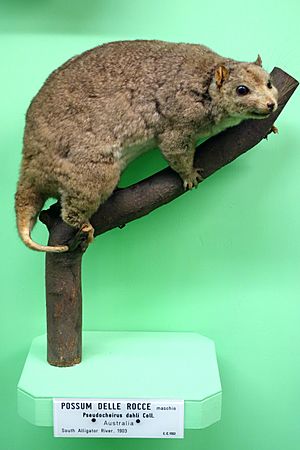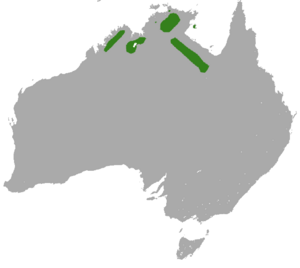Rock-haunting ringtail possum facts for kids
Quick facts for kids Rock-haunting ringtail possum |
|
|---|---|
 |
|
| Conservation status | |
| Scientific classification | |
| Genus: |
Petropseudes
|
| Species: |
dahli
|
 |
|
| Rock-haunting ringtail possum range | |
The rock-haunting ringtail possum (Petropseudes dahli) is a special type of possum found in Australia. It is also known as the rock ringtail possum. You can find it living in rocky areas in places like the Kimberley and Arnhem Land. It also lives on Groote Eylandt. This possum is the only species in its group, called Petropseudes. It is related to the common ringtail possum.
Local Aboriginal people, like the Kunwinjku of Western Arnhem Land, call this possum Ngingma or Djorrkun. They used to hunt it by putting out sweet honey as bait. When the possum came to eat, they would catch it.
The rock-haunting ringtail possum has one of the shortest tails among all ringtail possums. The end of its tail has no fur and looks scaly. These possums live in small groups. They mostly eat plants, making them herbivores. They have a strong body and are usually grey.
Contents
What Does the Rock-Haunting Possum Look Like?
The rock-haunting ringtail possum is about the size of a small rabbit. Its fur is grey to reddish-grey on its back. Its belly is a light cream color. It has white fur patches under its small, round ears. It also has white fur above and below its eyes. A dark stripe runs from the top of its head down its back.
Like other possums, it has a prehensile tail. This means it can use its tail to grasp things, like branches. But its tail is special because only the first half is covered in fur. Males are about 33 to 38 centimeters long. Females are usually bigger, measuring 35 to 38 centimeters. They weigh between 1.2 and 2 kilograms. Another unique thing about this possum is that it has vertical pupils in its eyes.
How the Rock-Haunting Possum Lives
The rock-haunting ringtail possum helps its environment in a few ways. When it eats fruit, it spreads the seeds around. It also affects termite populations. Many other animals in its area hunt it for food.
Sadly, human activities have changed the possum's habitat. This has caused its numbers to drop a lot. Because of this, it is listed as a priority species in Western Australia. This means it needs special protection.
Where the Rock-Haunting Possum Lives
The rock-haunting ringtail possum lives only in rocky areas. It loves places with big rocks and deep cracks. It uses these cracks to hide. It often just sticks its head into a crack, leaving its body outside.
This possum is nocturnal, meaning it is active only at night. It leaves its safe rock cracks to climb trees and find food after dark. It does not build a nest. Sometimes, it sleeps on protected rock ledges during the day. This shows it is very good at living on the ground. It has shorter legs, shorter claws, and a shorter tail than other possums. These features help it move around on rocks.
What the Rock-Haunting Possum Eats
The rock-haunting ringtail possum eats fruits, flowers, and leaves from many different trees. These trees grow near its rocky home. Sometimes, it also eats termites. It usually stays close to the rocks when it eats. However, it has been seen as far as 100 meters away from the nearest rock.
Some of the flowers it eats come from Darwin Woollybutt (Eucalyptus miniata) and Darwin Stringybark (Eucalyptus tetrodonta). Its main fruit diet includes Zyziphus oenoplia, Vitex glabrata, Billy Goat Plum (Terminalia ferdinandiana), and Owenia vernicosa. It also eats leaves from plants like Flagelleria indica, Pouteria sericea, and Vine Reedcane.
Who Hunts the Rock-Haunting Possum?
Several animals hunt the rock-haunting ringtail possum. These include the Dingo (Canis lupus dingo), the Oenpelli Python (Morelia oenpelliensis), and the Olive Python (Liasis olivaceous). Quolls (Dasyurus spp.), owls (Strigiformes), feral cats (Felis catus), and domestic dogs (Canis lupus familiaris) also hunt it. Even humans (Homo sapiens) have hunted them.
To stay safe, this possum spends a lot of time watching for danger. It sits on branches or ledges and looks around for predators. If it sees a threat, it beats its tail hard against tree branches. This makes the whole tree shake and warns other possums.
Rock-Haunting Possum Family Life
Among all Australian possums, the rock-haunting ringtail possum has the closest family groups. Adults and their young stay very close, usually within 2 to 3 meters of each other at night. Family groups typically have about 4 members. However, groups from 2 to 10 individuals have been seen.
This possum spends most of its day hiding in rock piles or cracks. After it gets dark, it leaves its rocky home to find food in nearby trees. This possum is shy and hard to catch. It tries to avoid contact and fights whenever possible. It mostly lives on the ground, only going into trees to eat. This makes it different from its relatives, who usually live in trees. Its eyes shine very brightly in a spotlight. But unlike most possums, it does not freeze when caught in a light beam. Instead, it runs back to its rock shelter. It hides its head in the crack, but its body might still be visible.
Reproduction and Life Cycle
There is no special time of year when these possums breed. However, females with young in their pouch and young on their back have been seen in March, July, August, and September. We do not know exactly how long the mother is pregnant for this species. But its close relatives are pregnant for about 16 to 30 days.
New babies spend their first five weeks inside the mother's large pouch. The pouch has two teats for feeding. After leaving the pouch, the parents usually carry the young on their backs. Both parents share the job of caring for the young almost equally. Older siblings often stay with the family and help raise the new babies. The parents protect their young by watching for predators. They also beat their tails and make sounds to warn others. They keep the young close to them.
Home Range and Pair Bonds
Both male and female possums have a similar home range size. Their average home range is about 0.9 hectares, which is like a small park. These areas can be from 0.5 to 1.2 hectares in size. On average, there are about 0.4 possums per hectare in these areas.
Female possums live with one male in their home range. They often mark their areas with scent posts. To do this, the possum rubs or presses its rear end or chest against a surface. They mark rock ledges and trees within their home range. But they mark their den sites the most strongly.
The rock-haunting ringtail possum is one of the few monogamous marsupials. This means that a male and female form a strong, lasting pair bond. They stay together and are attracted to each other. Both sexes of this possum keep strong pair bonds. They show this by doing many things to keep the bond strong. Males tend to work harder at keeping the bond than females. Both the male and female decide together when the group will do things.
Parents and young in this species also have long-lasting bonds. This is another sign of monogamy. Both male and female rock-haunting ringtail possums take care of their young for a long time. An interesting thing they do is "bridge formation." The mother lets her young move from branch to branch by using her body as a bridge. This has never been seen in any other possum. Adults also hug their young. This helps them know how much the young have grown. A third sign of monogamy is that older young help raise their younger brothers and sisters.
How the Rock-Haunting Possum Communicates
The rock-haunting ringtail possum mostly uses scent to talk to each other. Adult possums have a special gland on their chest. Males also have another gland near their rear end, about 2 centimeters wide. The possum keeps scent posts that it visits often. It uses both urine and droppings to mark these areas. This possum is also thought to mark tree branches using its gland.
The rock-haunting ringtail possum has been seen hitting its tail against rocks. This might be another way they communicate. The species can also make quiet screeches and grunts. These sounds help them talk to each other too.
See also
 In Spanish: Falangero rupestre para niños
In Spanish: Falangero rupestre para niños


